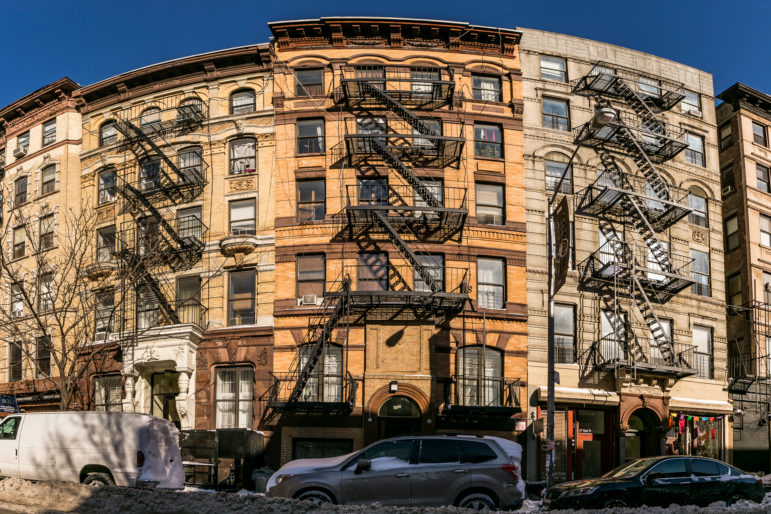“Now, longtime neighborhood residents across the city, people who put up with dangerous housing conditions for decades because they had no choice, but who fought to improve their neighborhoods, finally have the best chance in decades to get public support.”

Adi Talwar
Three buildings in the East Village are a part of the Cooper Square Community Land Trust.The Lower East Side, 1970s.
It was a short five blocks from my apartment on East 4th Street, between Avenues C and D, to my job at a local community organization in the abandoned P.S. 64 on East 9th Street, later re-named El Bohio. What I saw in those five blocks, back and forth each day, was an unfolding trend spreading its poison throughout the neighborhood: landlords withdrawing basic services from their buildings and sometimes even torching them to collect on the insurance, before abandoning them altogether.
There were empty lots where buildings once stood and buildings with fire-damaged apartments and boarded up windows. The Fire Department painted an X with a box around it to proclaim a building dangerous—warning others to “keep out.” Soon drug users lined up at the thriving drug market that grew up on my block.
And yet there were local people who were reclaiming buildings by “homesteading”—cleaning out and rebuilding with found or salvaged materials. Those efforts were at first few and far between. But then some enlightened city bureaucrats saw the promise of letting the tenants in the buildings and the community organizations sprouting locally to take over, run and save them. Soon, city funds were earmarked for these purposes.
Amid all of this ruin, families doubled up; others moved away. The neighborhood folks who stayed became the troops fighting to reverse the disinvestment and abandonment. More buildings were reclaimed and some vacant, garbage-strewn and rat-infested lots were turned into magnificent community gardens, some with casitas, as residents worked to soothe the wounds of displacement by creating dignity and shared community space.
When we finally managed to salvage and stabilize the neighborhood, we realized that we had inadvertently made it safe for gentrification. Now new landlords were coming in and buying and flipping buildings, bidding up prices and pushing longtime residents out. State policy rolled back rent regulations, and city policy granted for-profit developers cheap access to those now vacant lots. Both these measures crowded out other efforts to keep the neighborhood affordable for the people who had fought to save it. Many of these same policies persist today, decades after they were instituted during the Koch and Giuliani administrations.
On several other blocks on the Lower East Side, a community organization—the Cooper Square Committee—organized to save 21 buildings with over 300 apartments, first from the wrecking ball of urban renewal plans in the 1960s, and then from gentrification in the 1980s. They set up a Community Land Trust (CLT), that won a deed from the city to own the land and a state- approved Mutual Housing Association to manage the buildings on it.
It remains, nearly 30 years after it was founded, an oasis in the neighborhood, where working-class, mostly Latinx tenants live together and manage their buildings collectively, and do so at a fraction of the rents charged in the rest of the neighborhood.
Today, there are Community Land Trusts forming across all five boroughs of the city, with a mission to preserve and develop deeply affordable housing and prevent displacement, and to bring new community centers, artists’ and manufacturing spaces back into neighborhoods that need them. And now, longtime neighborhood residents across the city, people who put up with dangerous housing conditions for decades because they had no choice, but who fought to improve their neighborhoods, finally have the best chance in decades to get public support.
The Community Land Act, a package of three bills currently in the City Council, would slow down overheated real estate transactions, give tenants and community groups a chance to bid on housing when it comes to market, and prioritize community-based organizations in the disposition of public land. Several other bills would help to subsidize rents for very poor tenants and create a land bank to hold public land for a time when it can be developed for affordable, community-determined uses.
Without the control that these bills give to our communities, local residents will again be called upon to solve the housing problem at our own expense
Harriet Cohen is the president of the Cooper Square Community Land Trust.









2 thoughts on “Opinion: With Community Land Trusts Back in the Spotlight, Lessons from 1970s NYC”
‘ The Community Land Act, a package of three bills currently in the City Council, would slow down overheated real estate transactions, give tenants and community groups a chance to bid on housing when it comes to market, and prioritize community-based organizations in the disposition of public land. ‘
The courts will throw out this obviously unconstitutional law if passed. A property owner cannot legally be forced to even consider an offer they are not interested in. They also cannot be forced to sell a property only after certain amount of time. And the city is obligated by law to sell city-owned land/buildings to the highest bidder.
Learn more about Cooper Square Committee and community land trusts! Download “Rabble Rousers: Fran Goldin and the Fight for Cooper Square.” The film is available free on the Kanopy platform with a NY library card.